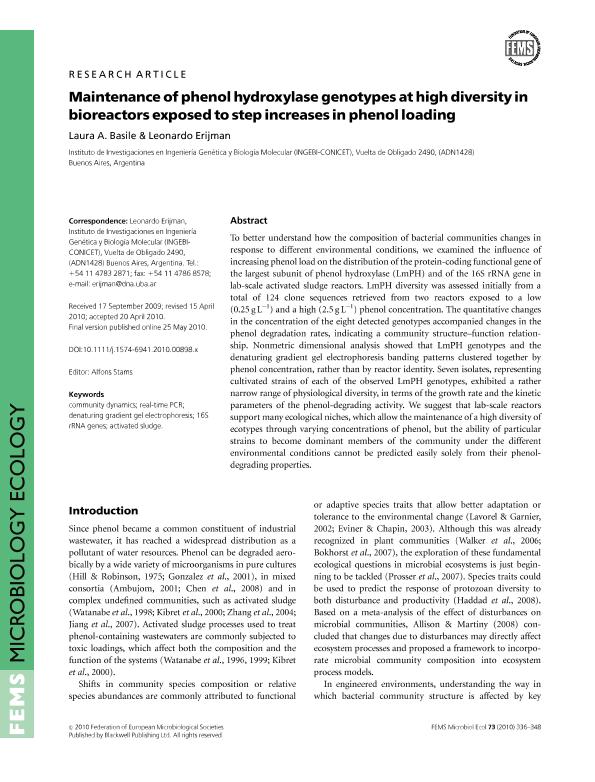Mostrar el registro sencillo del ítem
dc.contributor.author
Basile, Laura Ana

dc.contributor.author
Erijman, Leonardo

dc.date.available
2019-07-15T20:42:49Z
dc.date.issued
2010-08
dc.identifier.citation
Basile, Laura Ana; Erijman, Leonardo; Maintenance of phenol hydroxylase genotypes at high diversity in bioreactors exposed to step increases in phenol loading; Wiley Blackwell Publishing, Inc; Fems Microbiology Ecology; 73; 2; 8-2010; 336-348
dc.identifier.issn
0168-6496
dc.identifier.uri
http://hdl.handle.net/11336/79588
dc.description.abstract
To better understand how the composition of bacterial communities changes in response to different environmental conditions, we examined the influence of increasing phenol load on the distribution of the protein-coding functional gene of the largest subunit of phenol hydroxylase (LmPH) and of the 16S rRNA gene in lab-scale activated sludge reactors. LmPH diversity was assessed initially from a total of 124 clone sequences retrieved from two reactors exposed to a low (0.25 g L-1) and a high (2.5 g L-1) phenol concentration. The quantitative changes in the concentration of the eight detected genotypes accompanied changes in the phenol degradation rates, indicating a community structure-function relationship. Nonmetric dimensional analysis showed that LmPH genotypes and the denaturing gradient gel electrophoresis banding patterns clustered together by phenol concentration, rather than by reactor identity. Seven isolates, representing cultivated strains of each of the observed LmPH genotypes, exhibited a rather narrow range of physiological diversity, in terms of the growth rate and the kinetic parameters of the phenol-degrading activity. We suggest that lab-scale reactors support many ecological niches, which allow the maintenance of a high diversity of ecotypes through varying concentrations of phenol, but the ability of particular strains to become dominant members of the community under the different environmental conditions cannot be predicted easily solely from their phenol-degrading properties.
dc.format
application/pdf
dc.language.iso
eng
dc.publisher
Wiley Blackwell Publishing, Inc

dc.rights
info:eu-repo/semantics/openAccess
dc.rights.uri
https://creativecommons.org/licenses/by-nc-sa/2.5/ar/
dc.subject
16s Rrna Genes
dc.subject
Activated Sludge
dc.subject
Community Dynamics
dc.subject
Denaturing Gradient Gel Electrophoresis
dc.subject
Real-Time Pcr
dc.subject.classification
Biología Celular, Microbiología

dc.subject.classification
Ciencias Biológicas

dc.subject.classification
CIENCIAS NATURALES Y EXACTAS

dc.title
Maintenance of phenol hydroxylase genotypes at high diversity in bioreactors exposed to step increases in phenol loading
dc.type
info:eu-repo/semantics/article
dc.type
info:ar-repo/semantics/artículo
dc.type
info:eu-repo/semantics/publishedVersion
dc.date.updated
2019-07-10T19:05:38Z
dc.journal.volume
73
dc.journal.number
2
dc.journal.pagination
336-348
dc.journal.pais
Reino Unido

dc.journal.ciudad
Londres
dc.description.fil
Fil: Basile, Laura Ana. Consejo Nacional de Investigaciones Científicas y Técnicas. Instituto de Investigaciones en Ingeniería Genética y Biología Molecular "Dr. Héctor N. Torres"; Argentina
dc.description.fil
Fil: Erijman, Leonardo. Consejo Nacional de Investigaciones Científicas y Técnicas. Instituto de Investigaciones en Ingeniería Genética y Biología Molecular "Dr. Héctor N. Torres"; Argentina
dc.journal.title
Fems Microbiology Ecology

dc.relation.alternativeid
info:eu-repo/semantics/altIdentifier/doi/https://doi.org/10.1111/j.1574-6941.2010.00898.x
dc.relation.alternativeid
info:eu-repo/semantics/altIdentifier/url/https://academic.oup.com/femsec/article/73/2/336/542964
Archivos asociados
